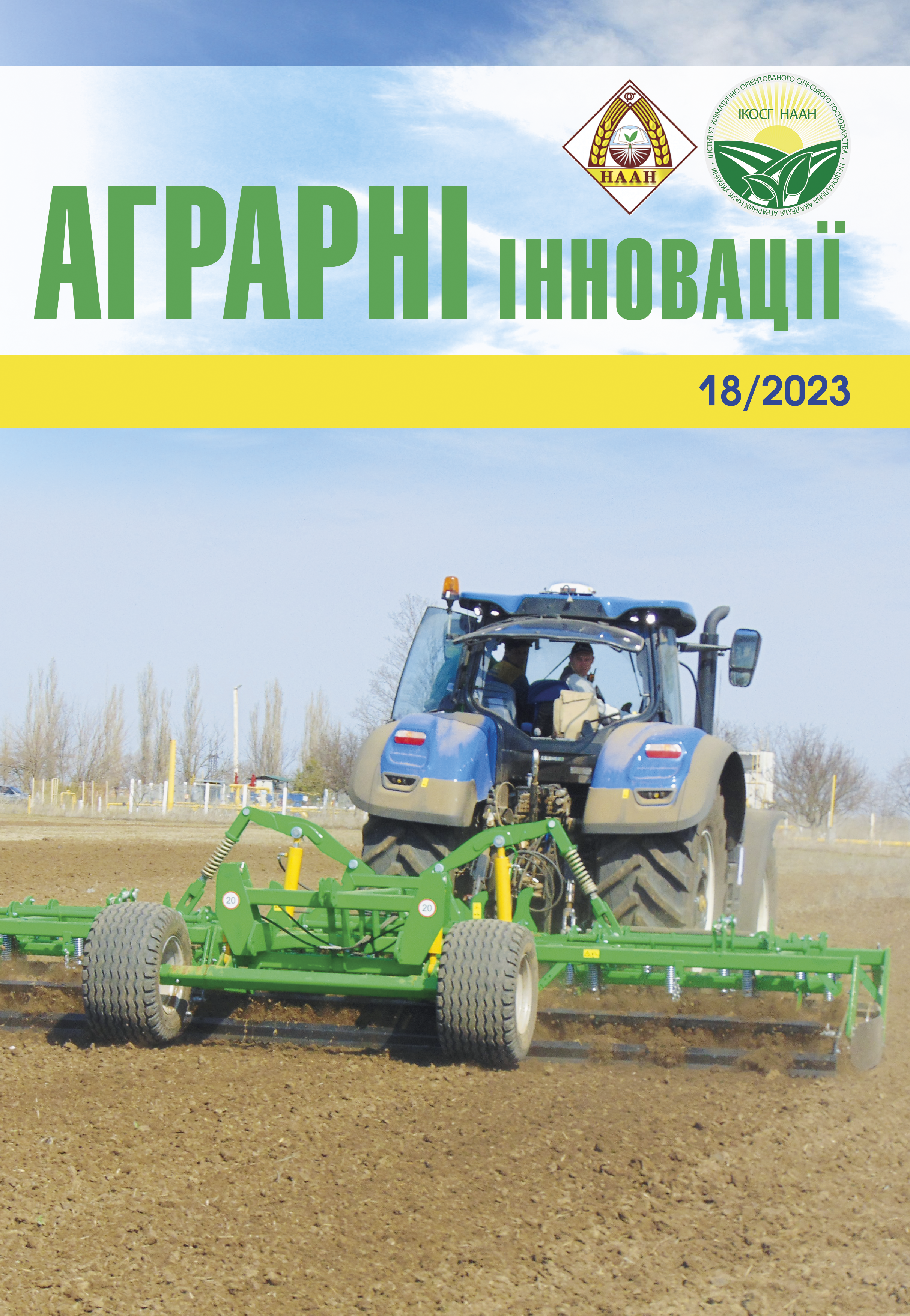CHARACTERISTICS OF MUTATION INDUCTION BY THE ACTION OF NITROSOETHYLUREA IN WINTER WHEAT
Abstract
Nitrosoalkylureas as a mutagenic factor belong to the group of substances capable of causing high frequencies of mutations in the structure of plants, which will lead to the emergence of a large number of intensive forms. Purpose. The aim was to reveal the features of induction of the frequency and spectrum of mutational changes in winter wheat in the second-third generation, to show the key points of mutational variability by individual characters and depending on the genotype. Methods. Seeds of 8 varieties of winter wheat Balaton, Borovytsia, Zeleny Gai, Zoloto Ukrainy, Kalancha, Niva Odeska, Polyanka, Pochayna were treated with a solution of the chemical mutagen nitrosoethurea (NEU) in concentrations of 0.01, 0.025%. In the M2–M3 generations, mutant families were selected by visual assessment, analysis, structural analysis by phenophases and grain yield analysis. Results. 12,000 families in the second-third generation were studied. Usual concentrations typical for breeding practice were used. At the same time, even a higher concentration of NEU of 0.025% did not lead to a significant decrease in viability. With statistical reliability, the overall frequency of mutations was influenced by the indicator of increased concentration, in a pairwise comparison, the varieties Polyanka and Pochayna differed significantly, in all cases the variants differ from each other and from the control. The level of variability was influenced by both the increase in concentration and the genotype indicator, and when paired, varieties Kalancha, Polyanka, and Pochayna were separated. In the spectrum, a total of 34 changed traits in 6 groups of variability were obtained, it is possible to reliably predict for this mutagen on this material a high number (in comparison) of high-stemmed mutants, forms with a long length spike. The probability of genotype classification in the factor space is quite high. There is a high probability of obtaining valuable forms with a long length spike, productive and bushy, early-ripening mutants. At the same time, there is a high probability of obtaining forms with a speltoid spike, a tall stem, which are negative traits. Also, this agent has a significantly weaker effect on the emergence of sterile forms, which is already positive. Findings. The used initiating material is quite promising especially in combination with moderate concentrations of NEU, so it can be considered that the optimal composition in the case of these varieties is the use for high induction of valuable forms of NEU in a concentration of 0.025% with the vast majority of the specified genotypes. Even in the low-variable under the effects of NEU, the number of valuable families and plants is significantly higher under the effects of this mutagen.
References
2. Anter A. Induced Mutations in Wheat (Triticum aestivum L.) and Improved Grain Yield by Modifying Spike Length. Asian Journal of Plant Sciences. 2021. 20: P. 313-323. Retrieved January 14, 2023, from doi: 10.3923/ajps.2021.313.323
3. Chaudhary J., Deshmukh R., Sonah H. Mutagenesis Approaches and Their Role in Crop Improvement. Plants. 2019. 8, 467.
4. Mangi N., Baloch A. W., Khaskheli N. K., Ali M., Afzal W. Multivariate Analysis for Evaluation of Mutant Bread Wheat Lines Using Metric Traits. Integrative Plant Sciences. 2021. 1(1), 29–34.
5. Nazarenko M., Izhboldin O. Izhboldina O. Study of variability of winter wheat varieties and lines in terms of winter hardness and drought resistance. AgroLife Scientific Journal. 2022. 11(2), 116–123.
6. Nazarenko M. Identification and characterization of mutants induced by gamma radiation in winter wheat (Triticum aestivum L.). Scientific Papers. Series A. Agronomy. 2016. LIX. Р. 350–353.
7. Shabani M., Alemzadeh A., Nakhoda B., Razi1 H., Houshmandpanah Z., Hildebrand D. Optimized gamma radiation produces physiological and morphological changes that improve seed yield in wheat. Physiology Molecular Biology Plants. 2022. 28(8). 1571–1586.
8. Spencer-Lopes M.M., Forster B.P., Jankuloski L. Manual on mutation breeding. Third edition. Food and Agriculture Organization of the United Nations, Rome. 2018. Р. 672.
9. Udage A. Introduction to plant mutation breeding: different approaches and mutagenic agents. Journal of Agricultural Sciences – Sri Lanka. 2021. 16. 466.
10. Yali W., Mitiku T. Mutation Breeding and Its Importance in Modern Plant Breeding. Journal of Plant Sciences. 2022. 10(2). 64–70.






